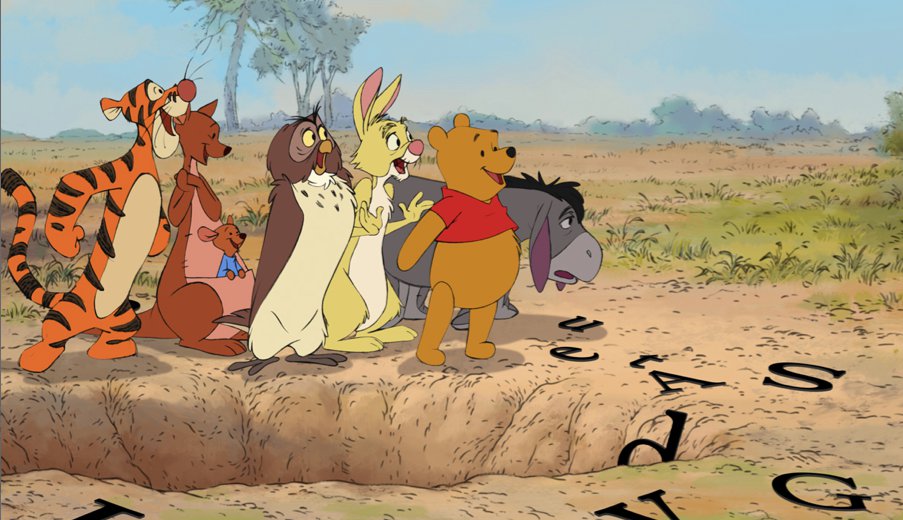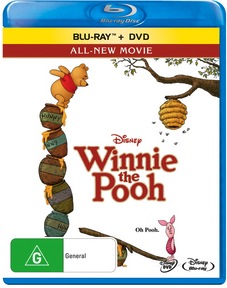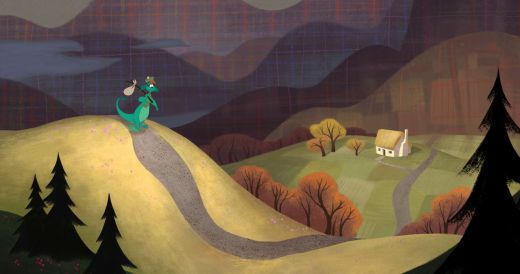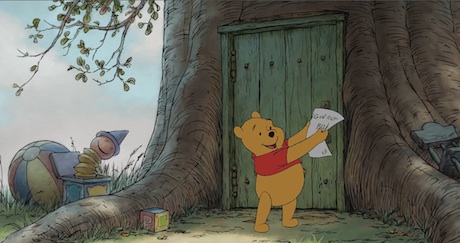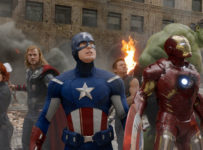[stextbox id=”grey” caption=”Disc Specifications” float=”true” align=”right” width=”220″]
Director: Stephen J. Anderson, Don Hall
Runtime: 63 minutes
Starring: Jim Cummings, Craig Ferguson, John Cleese
Video: 1080p HD/ 1.78:1 (16:9)
Audio:
- DTS HD Master Audio 5.1 – English
- Dolby Digital 5.1 – Spanish, French
- Audio Description – English
Subtitles: English, Spanish, French, English HoH
Extras:
- Featurette
- Deleted Scenes x 5 (with Intro)
- Short Films
- Sing-Along
- Song Selection
Distributor: Disney

When A.A. Milne first published the Hundred Acre Wood stories in 1926, based on the stuffed toys that populated his son’s room, even his imagination would not have been able to fathom the $5.7 billion franchise that the bear of very little brain would eventually grow into. Although E.H Shepherd created the brilliant original illustrations for Milne’s books, it is perhaps the Disney versions of the Pooh characters that most are familiar with today, thanks to the three featurettes that would eventually form 1977’s feature The Many Adventures of Winnie the Pooh. Over three decades, several television series and a handful of full-length films later, the House of Mouse returns to their second most marketable character after Mickey Mouse.
Pooh (voiced by Jim Cummings, Gnomeo and Juliet) wakes to find that he is out of honey, and he and his rumbly tumbly set out to find some more. On the way, he discovers that Eeyore has lost his tail, so he enlists the other inhabitants of the Hundred Acre Wood to help the depressive donkey find his rear appendage. Christopher Robin decides to hold a contest to fail the tail, with the prize a delicious pot of honey for Pooh, Tigger, Owl, Rabbit, Kanga or Roo. Of course, things never go as smoothly as that when honey is involved.
Winnie the Pooh marks Disney’s first use of the Walt Disney Animation Studio on these characters since the original film, with all subsequent Pooh outings having been handled by the television or direct-to-video divisions of the studio. As such, the results are visually stunning, with 1974’s Winnie the Pooh and Tigger Too animator Burmy Mattinson acting as the storyboard artist for the film. Joining The Princess and the Frog as the only hand-drawn animated feature in the last half-decade from the studio, it was an interesting choice for what many would consider to be a foregone cash-cow for Disney. Yet the style is consistent with the storybook origins of the film, and instantly recalls the original Winnie the Pooh adventures.
Opening with the same live action pieces that were seen in the original adventures, the red-shirted version of Pooh is wholly Disney’s, and something that E.H. Shepherd referred to as a “travesty”. However, it is hard to be so harsh on something this beautifully animated. Characters are drawn in simple line style, utilising the likes of supervising animators Mark Henn and Andreas Deja, both veterans of 1980s Disney (The Black Cauldron, The Great Mouse Detective), through the golden years of The Little Mermaid, The Lion King and Beauty and the Beast, right up until The Princess and the Frog. CGI is employed, but for the characters to interact with the text of the book. The more imaginative scenes include the chalkboard Backson sequences, and although these are nowhere near as iconic as the Heffalumps and Woozles of the earlier toons, it is a stunning sequence to watch.
Rather than populating the film with recognisable voices, and the kind of stunt casting that bigger budget films are often guilty of, Disney has gone back to the reliable voice talent of Jim Cummings, the voice of Pooh and Tigger for over twenty years. One notable regular absent is Peter Cullen, who has voiced Eeyore for the last fifteen years, only to be replaced by Bud Luckey here. Perhaps Disney just saw his work as Optimus Prime in Transformers: Dark of the Moon and ran the other way. The only “celebrities” present are late-night talk-show host Craig Ferguson, downplaying any idiosyncrasies as Owl, and the dulcet tones of actress Zooey Deschanel and musician M. Ward, better known collectively as She & Him, providing several songs for the soundtrack. Of course, it is John Cleese’s narration that ties the film together, with his distinctive vocals gently mocking the events on screen.
Based on three separate tales from the original Milne stories, “In Which Eeyore Loses a Tail and Pooh Finds One”, “In Which Piglet Meets a Heffalump” and “In Which Rabbit Has a Busy Day and We Learn What Christopher Robin Does in the Mornings”, Winnie the Pooh is in no particular hurry to tell its story. There is a gentle whimsy to proceedings, taking its time to wink at the audience. It’s like spending the day with some old friends, albeit ones that can be found on lunch-boxes and in plush toy form. Yet if one criticism were to be levelled at the film, it would only be that it is too short at 63 minutes, with audiences surely willing to spend more time with these favourite characters. Indeed, it is a good 11 minutes shorter than the 1977 feature film, and thanks to Pixar and similar features, younger audiences have grown used to films much longer than this. A minor quibble, for Winnie the Pooh is practically perfect in every other way.
The Disc:
In Australia, this disc is incredibly hard to come by. We get it several weeks prior to the US on the dual formats, but it is exclusive to Big W. The Blu-ray is presented in a pristine 1.78:1 1080p transfer, gloriously bringing to life the sharp 2D animation and the meticulous rendered backgrounds. The audio is somewhat restrained, despite being a DTS HD Master Audio 5.1 track. This is not to say it is in any way poor, as the audio is always crisp and fills the room, especially Zooey Deschanel’s beautiful singing voice. The source material simply does not lend itself to rattling the windows.
Winnie the Pooh and His Story Too (8:33) is the closest we get to a making of on the disc, although it is a far cry from the hours of behind-the-scenes footage that once graced Disney DVDs. It is a (honey) potted history of the character, but a slim one at that. The 5 Deleted Scenes (15:06) comes with some introductions from the two directors, including extended scenes and alternate character introductions. However, given that the film was only 63 minutes, the repeated explanation of these scenes being “cut for pacing” seems a bit odd.
The best extras are undoubtedly the Bonus short films. The Ballad of Nessie (5:32) screened with the film theatrically, narrated by Billy Connelly. There’s also another Winnie the Pooh short called the Mini Adventures of Winnie the Pooh: Pooh’s Balloon (2:47), although this seems to be an excerpt from the 1966 short Winnie the Pooh and the Honey Tree, and the 1977 feature. The last standalone featurette is Creating the Perfect Winnie the Pooh Nursery (2:52), with Ellie and Melissa The Baby Planners®. Clearly aimed at (expecting) parents, and not Blu-ray collectors. There’s also a Sing-Along With the Movie option, giving karaoke subtitle track to the songs, and the ability to skip to one of 7 songs in the film.
The set also comes with a bonus DVD of the film, with the feature and a handful of extras.
[stextbox id=”custom”]Winnie the Pooh is an absolute joy for all ages, and harks back to the classic days of Disney animation. The Blu-ray may not be packed, but it is gorgeous to look at and well-worth picking up.[/stextbox]
Winnie the Pooh is released on Blu-ray and DVD in Australia on 6 October 2011 from Disney. It will be released in the US on Blu-ray and DVD on 25 October 2011.


